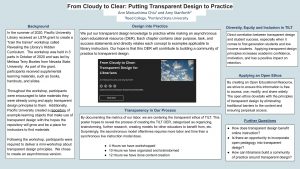
Background:
In the summer of 2020, Pacific University Library received an LSTA grant to create a “train the trainer” workshop called Revealing the Library’s Hidden Curriculum. The workshop was held in 3 parts in October of 2020 and was led by Melissa Bowles-Terry from Nevada State University. As part of the grant, participants received supplemental learning materials, such as books, handouts, and slides.
Throughout the workshop, participants were encouraged to take materials they were already using and apply transparent design principles to them. Additionally, Pacific University created a repository of example learning objects that make use of transparent design with the hopes the repository will grow and be a place for instructors to find materials.
Following the workshop, participants were required to deliver a mini-workshop about transparent design principles. We chose to create an asynchronous version.
Design into Practice:
We put our transparent design knowledge to practice while making an asynchronous open educational resource (OER). Each chapter contains clear purpose, task, and success statements and directly relates each concept to examples applicable to library instructors. Our hope is that this OER will contribute to building a community of practice to transparent design.
Transparency in our process:
By documenting the metrics of our labor, we are centering the transparent ethos of TILT. This poster hopes to reveal the process of creating the TILT OER, categorized as organizing, brainstorming, further research, creating models for other educators to benefit from, etc. Surprisingly, the asynchronous model oftentimes requires more labor and time than a synchronous live instruction model does.
- 4 Hours we have workshopped
- 10 Hours we have organized and brainstormed
- 12 Hours we have done content creation
Diversity, Equity and Inclusion in TILT:
Direct correlation between transparent design and student success, especially when it comes to first generation students and low income students. Applying transparent design principles increases academic confidence, motivation, and has a positive impact on retention.
Applying an Open Ethos:
By creating an Open Educational Resource, we strive to ensure this information is free to access, use, modify, and share widely. The open ethos dovetails with the principles of transparent design by eliminating traditional barriers to the content and ensuring perpetual access.
Further Questions:
- How does transparent design benefit online instruction?
- Is there an opportunity to incorporate open pedagogy into transparent design?
- How can librarians build a community of practice around transparent design?
Citation:
Stanforth, A. and Chiu, A.M. (2021). From Cloudy to Clear: Putting Transparent Design to Practice. Poster presented at Oregon Library Association Conference, Online.

